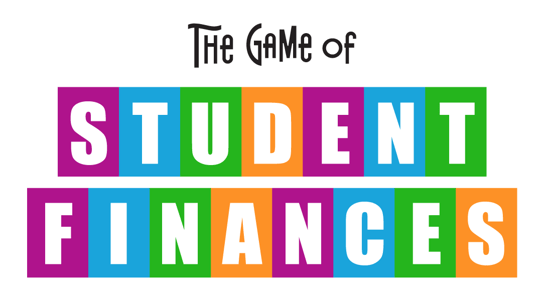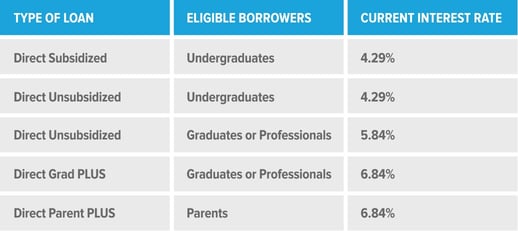When you were little, The Game of LIFE was one of the most exhilarating games to play. Every card you drew and every move you made would determine what your future would look like.
Now you are grown up, and paying for college isn’t as easy as drawing a card from the banker and hoping that your career will pay for it.
Now the Game of LIFE is real, and so is paying for college.
“Accidentally” flipping the game board over isn’t an option here, so pay close attention to the guide below. Following suit of our favorite childhood game, here are the instructions to the very real Game of Student Finances.
Tackling your finances when you are a student can be overwhelming. When we played LIFE, we didn’t have to call our student loan manager or figure out what student loans even were. We just followed the squares.
Consider this guide your game board. Here are your squares. Spin. Move one space now.
 In LIFE, we were required to move spaces on the board no matter how we felt. But in your college career, you have the chance to make choices.
In LIFE, we were required to move spaces on the board no matter how we felt. But in your college career, you have the chance to make choices.
Instead of resorting to loans, you have other options to pay for school.
Spin. Move 1 space to obtain a scholarship.
 Scholarships are awarded for just about everything. You can receive scholarships for being a minority, writing well, or being involved in a specific field. Even if you are currently enrolled in college, you can still receive scholarships.
Scholarships are awarded for just about everything. You can receive scholarships for being a minority, writing well, or being involved in a specific field. Even if you are currently enrolled in college, you can still receive scholarships.
Remember those handy “Share the Wealth” cards in LIFE? Yeah, that is what a scholarship is essentially.
Most people know that scholarships exist; they just don’t know where to begin with them. Here are some of the most common scholarship questions that students ask.
Where do I find scholarships?
Start by checking your college’s website for scholarships they offer. Many institutions award plenty of scholarships each year that many students are unaware of. These scholarships are rarely sought after, which increases your chances of being selected. Also, these scholarships are usually tailored to your major, making it easier for you to find a scholarship that matches your qualifications. If you know what school you would like to attend, you can apply for these scholarships even before you begin attending your school.
Other popular ways to find scholarships are through online scholarship portals. Some of the best scholarship aggregators are found online.
Some sites to check out for scholarships are the CollegeBoard’s Scholarship Search, Fastweb.com, or Scholarships.com. When searching for scholarships through these sites, be sure to uncheck the boxes that may allow these sites to solicit your information to advertisers. Collegeboard definitely will not allow this to happen, but other sites may. Most of these sites can be very helpful; you just have to read the fine print.
Another way to find scholarships that you may be eligible for is through filling out the FAFSA.
How do I apply for scholarships?
This one isn’t going to be as easy as landing on a square. Most scholarship applications require an essay, some form of academic transcripts, or a form of visual representation that you are qualified to receive this scholarship.
You can always find all of the information you will need to apply directly on the scholarship’s website.
The fact remains, scholarships can only cover so much, but by applying for scholarships you can relieve yourself of some of the debt you may accumulate.
Think of your money like you did when you played board games. Every time you were able to snag money from one of your wealthy opponents because of an achievement, you didn’t think twice. Scholarships work the same way.
If you are getting money in this way, you are paying less money to “the banker” in the future.
As we mentioned before, scholarships are also available to students who are already enrolled in school. Check with your advisor at your college. They often know about scholarships students wouldn’t be able to find on their own.
When should I apply for scholarships?
As soon as you decide you want to attend college, begin your scholarship search. Scholarships are essentially free money. If you are attending college, free money of any sort is always a good thing. Apply for scholarships no matter what your financial situation looks like.
Beware: Many scholarships have strict deadlines. In LIFE, we chose to (or not to) attend college the moment we began playing the game, and that is exactly what scholarship providers think you have done here as well. Scholarships are fantastic, but you must be quick with deadlines. The moment you know you want to attend college, or are even considering it, apply for scholarships. These deadlines often occur early in the year and are very firm to ensure that the company has enough time to review applications before selecting a recipient.

Grants
The second most common form of financial aid is through grants. Grants are free money that is awarded to students based on their economic situation. Think “Share the Wealth” cards, but from the government. If your family falls into a certain income level, you will be awarded money by either the state or federal government to help pay your schooling. Unlike scholarships, which are merit-based, grants are need-based, so your family’s income is accounted for.
How do I get grants?
Grants are obtained by filling out the Free Application for Federal Student Aid (FAFSA). The FAFSA is a free application that students fill out to determine how much aid they are eligible for. (You also use this form for student loans, but we will get to that later.)
The FAFSA requires you to know a bunch of information about both your and your parent’s financial history.
Here is a quick checklist of everything you need to fill out the FAFSA:
- Your Social Security number
- Your driver’s license number
- Your most recent federal income tax returns, W-2s, and other records of money earned. (Note: You may be able to transfer your federal tax return information into your FAFSA using the IRS Data Retrieval Tool.)
- Bank statements and records of investments (if applicable)
- Records of untaxed income (if applicable)
- An FSA ID to sign electronically
- Records of your income
- List of the schools you would like to apply to
If you are someone’s dependent (usually your parents), then you will need most of this information for them as well.
The FAFSA takes around 30 minutes to complete, which is really only an average play of your favorite board game, LIFE.
Perspective matters here. Thirty minutes may seem like a long time to fill out an application, but if it gets your car to Millionaire Estates quicker, the detour is worth the wait.
The FAFSA is the way your school determines how much money you need to attend school. The FAFSA calculates how much money it will cost you to attend school minus the amount of money your family is expected to contribute to your schooling.
Essentially, once your financial situation is assessed, you are given one of those fancy dollar amount LIFE tiles and off you go. Your school then tells the banker (the government) that you deserve the amount of money printed on your tile. They also lay out any money they would be willing to lend you.
The FAFSA often has funds that are on a first-come, first-served basis, so filling your FAFSA out early is only to your advantage. The FAFSA is available on January 1 every year.
The FAFSA is completed online on the FAFSA website and is completely free. For a complete guide to filling out the FAFSA, visit the Department of Education’s guide to filling out the FAFSA.
The instructions are as simple as a board game. Just a little set up, and you are on your way to victory.
What kind of grants are there?
The Federal Pell Grant: The Pell Grant is the most common grant that exists. The Federal Pell Grant, unlike a loan, does not have to be paid back. The amount of the grant changes every year, but for the 2016–17 award year (July 1, 2016, to June 30, 2017), the maximum award is $5,815. The amount you get, though, will depend on your financial need, your cost of attendance, your status as a full-time or part-time student and your plans to attend school for a full academic year or less. Your school can apply Federal Pell Grant funds to your school costs, pay you directly, or combine these methods.
Consider a Pell Grant to be one of the most common LIFE tiles. Most students are eligible, but your circumstances will determine how much money you receive. Instead of spinning for your luck here, though, your aid is calculated by the amount of money the government believes you need to go to college.
Federal Supplemental Educational Opportunity Grant (FSEOG): This grant is specifically for undergraduate students who have exceptional financial needs. LIFE didn’t account for this type of grant, because they considered every player to be equal. But in the real world, we know not everyone is set up with the same college financing situation. If you apply for the Pell grant, but still qualify for more aid, this may be an option for you. Not all schools choose to offer this grant, though. Check with your financial aid office to find out if you qualify.
TEACH Grant: The TEACH grant offers money for those specifically studying to become a teacher. The Game of LIFE prepared us most for this type of grant. Think back to when you played LIFE. If you chose not to go to college, you couldn’t obtain certain career cards. Also, these cards would grant you more money in the long run. Because teachers generally do not make a high salary, this grant helps them make their degree worthwhile in exchange for doing the public a service. The TEACH grant provides students with up to $4,000 a year for entering this low-income, yet high-need profession. To receive this grant you must agree to teach in a high-need field at an elementary school, secondary school, or educational service agency that serves students from low-income families for at least four complete academic years within eight years after completing (or ceasing enrollment in) the course of study for which you received the grant. If you do not meet these conditions, the grant turns into a loan that you must pay back.
Iraq and Afghanistan Service Grant: If your parent or guardian died while engaged in military service in Afghanistan or Iraq, you may be eligible for this grant. This grant is only available to those who meet this criteria and DO NOT meet the requirements for a Pell Grant.
The first step to acquiring any of these grants is filling out the FAFSA. Just as you can’t move along the game board without spinning, the FAFSA is the way to make your move for financial aid.
Savings
The most obvious, but most influential method of paying for college is by starting a savings account as soon as possible. If your parents didn’t begin saving for you when you were younger, you should begin saving as soon as you decide you would like to attend college.
LIFE taught us that the player with the most money at the end of the game won. While this isn’t always true, we can still use this model to focus on saving. Saving is one of the most effective ways to win LIFE, and to attend college. College savings allow students to fund their future on their own, which saves them or their family more in the long run.
Saving for college is hard because it can seem as though you are saving for nothing, but saving is one of the easiest ways to accumulate money for college.
If you are still in high school, get a part-time job and open a savings account. Give one of your parents access to the account and ask them to move money into your account every time you get paid.
The first step to getting paid is paying yourself. If you factor your savings into your budget just as you would your bills, you won’t feel like you are losing money.
Don’t use student loans to fund spending in school. Only use your loans to pay for the essential costs of school.
Working part-time while in college is one of the best ways to rid yourself of debt and accumulate savings. Start now by saving to pay off your student loans and when you get out of college you won’t be as strapped for money.
Savings is one of the most important and effective ways to pay for college.

 In LIFE, we were required to move spaces on the board no matter how we felt. But in your college career, you have the chance to make choices.
In LIFE, we were required to move spaces on the board no matter how we felt. But in your college career, you have the chance to make choices. Scholarships are awarded for just about everything. You can receive scholarships for being a minority, writing well, or being involved in a specific field. Even if you are currently enrolled in college, you can still receive scholarships.
Scholarships are awarded for just about everything. You can receive scholarships for being a minority, writing well, or being involved in a specific field. Even if you are currently enrolled in college, you can still receive scholarships.
